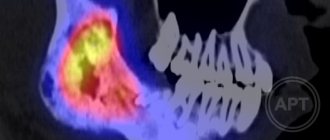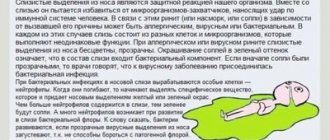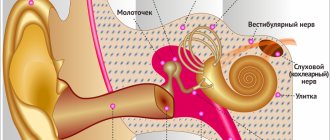1.General information
Laryngospasm (spasm of the larynx) is an involuntary and uncontrolled contraction of the muscles of the larynx, during which the glottis closes, the flow of air into the airways is blocked and a state of inspiratory asphyxia occurs (inability to inhale).
Prolonged asphyxia can lead to general oxygen starvation of tissues and death.
Due to the age-related characteristics of the structure and functioning of the ENT organs, laryngospasm is most often observed in children in the first months and years of life, but it also occurs in adults.
A must read! Help with treatment and hospitalization!
2. Reasons
Laryngospasm is a neuromuscular reflex that can be caused by many factors.
The main groups of such reasons include:
- inflammation in the respiratory system (pneumonia, bronchitis, tracheitis, laryngitis, etc.);
- neurodegenerative diseases (especially those affecting the spinal cord);
- infections and tumors of the central nervous system;
- severe generalized infections (eg, tetanus);
- irritation of the larynx with chemicals, allergens, medications, very cold or hot air;
- deficiency of vitamins and/or microelements;
- vascular pathology (severe hypertension, aortic aneurysm, etc.);
- neuropsychic factors (psychotrauma, hysterical attack, nervous overstrain, severe crying in children, fear or laughter);
- foreign bodies or tumors in the upper respiratory tract.
Visit our Otolaryngology (ENT) page
Factors in the development of spasms and suffocation in the throat
Often, pharyngeal spasm is situational, when its occurrence is caused by the influence of certain external causes on the human body. There are cases that such spasms are the body’s reaction to various irritations or injuries.
The causes of situational pharyngeal spasms are as follows:
- inhalation of air that contains an irritating substance;
- use of medications that have antispasmodic side effects;
- stress, emotional and physical stress, severe sharp pain.
And also the causes of spasms in the throat can be due to inaccurate food consumption, a relationship with various allergic sources in the body.
The spasmodic state is accompanied by problems with breathing and swallowing, but in some situations it can have a neurogenic development.
Throat spasms appear due to severe irritation of certain groups of nerves that are localized in the pharynx area. This happens if there is a goiter, a tumor of the esophagus, an aneurysm, or tetanus. Therefore, a feeling of a lump in the throat or difficulty in breathing may indicate a number of health problems.
Pathological groups that can provoke muscle spasms in the throat area.
- Endocrine diseases (damage to the thyroid gland).
- Psychoneurological disorders (hysteria).
- Infectious lesions of the upper respiratory tract (common factors are laryngitis, acute tonsillitis, pharyngitis).
A spasmodic state can also occur if there are vascular diseases, diseases of the stomach and intestines, cancer (damage to the nerve endings of the pharynx by large tumors), pathologies of the musculoskeletal system (spasms of the muscles of the pharynx and esophagus, hernia of the spine and neck).
3. Symptoms and diagnosis
Against the background of the above conditions, diseases and influences, laryngospasm often develops suddenly. However, in some cases it is preceded by such warning signs as shortness of breath, hoarseness or decreased voice volume (up to complete aphonia), and a “barking” cough with laryngitis. The classic clinical picture of laryngospasm includes changes in complexion, noisy shallow breathing, and panic (which in this condition can rapidly develop not only in a child, but also in an adult). The head is usually thrown back, and with severe hypoxia, cyanosis is observed. Choking, the patient may lose consciousness; in severe cases, cardiac arrest occurs. Sometimes laryngospasm is accompanied by an epileptiform seizure, including involuntary relaxation of the sphincters.
The duration of laryngospasm ranges from a few seconds to several tens of seconds. With hysteria, the attack passes spontaneously and does not require outside help (most often it is enough to eliminate the psychogenic situation or simply deprive the patient of the audience, i.e. leave the room).
If there is a predisposition to laryngospasms, they may occur repeatedly during the day. There is a tendency towards seasonality: laryngeal spasms are more often observed in the cold season.
The diagnosis is established clinically and anamnestiically. During laryngoscopy, a tight closure of the vocal cords and arytenoid cartilages is observed.
About our clinic Chistye Prudy metro station Medintercom page!
Main and accompanying signs of spasms
The main symptoms that appear as a result of throat spasms are divided into several groups.
Changes in the breathing process - the magnitude of throat spasms can range from slight difficulty in inhaling air (inspiratory dyspnea) to choking in the throat. When inhaling, a noise is heard, sometimes a slight whistle and a barking cough.
Sensation of a lump or foreign object in the throat - it is difficult for the patient to get rid of it; drinking water does not always improve well-being. Throat spasms may become stronger during swallowing.
Painful syndrome - characterized by pathological tension in the neck muscles. If you press lightly on the throat, the pain and spasm may become stronger.
The patient's skin becomes pale, and with prolonged spasmodic conditions, the throat becomes blue. The patient also breaks into a cold sweat when the throat spasms.
If a mild degree of throat suffocation occurs, the spasm passes within two minutes, and natural breathing and swallowing functions soon resume.
In case of severe throat disease and failure to provide timely medical treatment, additional symptoms may occur.
- Cramps.
- Foaming at the mouth.
- Sudden loss of reason.
All these symptoms lead to changes in the functioning of the cardiac and vascular system. As a result of such a painful condition of the pharynx, it can lead to the death of the patient.
Cramps associated with eating
Consumption of certain foods can cause sudden spasms of the muscles of the throat and esophagus. This directly occurs during food intake and after eating it.
A spasm in the throat can cause a large lump of dry, solid food. If you accidentally swallow a spicy fish bone, this will also lead to a change in the patency of the esophagus. Sometimes, to get it out of the throat, specialists practice surgical treatment.
Poor nutrition plays a direct role in reflux disease (eating spicy, fatty foods), which causes an increase in the acidity of juice in the stomach. In a patient who suffers from such a disease, hydrochloric acid is not completely thrown into the esophagus.
The food contained in the stomach irritates its walls, leading to a sharp contraction. When the throat spasms, the patient feels a lump when swallowing. Treatment of throat spasms due to reflux is carried out by a gastroenterologist.
Endocrine diseases
Frequent manifestations of pharyngeal spasm indicate endocrine diseases of the throat. The feeling of squeezing of the throat and lack of air is sometimes caused by a disease of the thyroid gland. This is caused by a painful growth of gland tissue - goiter.
The early stage of thyroid enlargement is characterized by sweating, asthenia, irritability, diarrhea, rapid heartbeat, and hand tremors. In moderate and severe cases of the disease, the pharynx is compressed.
Severe muscle spasms in the throat also occur when the parathyroid gland is damaged. When the level of parathyroid hormone decreases, this leads to a clear lack of calcium and an abundance of phosphates in the circulatory system. This imbalance is the cause of unbearable cramps. Painful sensations affect almost all muscles, the esophagus is no exception.
Psychoneurology
Spasms in the throat may appear due to a neuropsychiatric disorder. To refute or confirm the pathology, diagnosis is necessary.
Symptoms of spasms during neurosis begin to occur:
- from the impact of conflicts;
- long emotional circumstances that can cause mental trauma.
A large number of mental illnesses are presented in the form of a feeling of suffocation, a coma in the throat, severe trembling of the limbs and inside the body. Symptoms in patients manifest themselves in emotional colors, indicating pain in the abdomen, heart, a feeling of fear of death, and the impossibility of swallowing food. The slightest irritation can provoke a nervous breakdown.
Quite often, spasms are accompanied by a feeling of dryness in the mouth, difficulty breathing, and numbness of the larynx. The voice may also disappear, the person becomes hysterical, and his behavior changes.
Laryngospasm
A fairly common type of spasm is laryngospasm, which is manifested by contraction of the muscles of the pharynx of an involuntary nature. It occurs suddenly, accompanied by inspiratory shortness of breath.
In the human body, laryngospasm can have varying degrees. However, in severe cases, the development of suffocation in the throat is observed due to the complete connection of the vocal passage, which can lead to the death of the patient.
A sharp contraction of the pharynx in childhood is often diagnosed. The factors of this pathological condition are:
- progression of infectious diseases in the body, exposure to allergens and irritants in the air;
- long-term use of certain medications;
- lack of calcium and vitamin D in the body.
Symptoms that occur during spasms in the throat:
- pain in the throat, chest;
- inability to talk, swallow;
- feeling of a lump in the throat.
It is also difficult for the patient to take breaths, and he may break into a cold sweat. When the attack is at the terminal stage, breathing is noisy, with gradual normalization.
In children, the clinical picture is more pronounced. During laryngospasm, a child’s inhalation becomes whistling and the cough is barking. The skin becomes pale. Similar phenomena occur due to the baby being frightened, laughing, or crying heavily, resulting in swelling of the larynx, which often ends in stenosis and acute shortness of breath.
An attack with a slight spasm of the pharynx can go away on its own in two minutes. Severe cases of laryngeal spasms are life-threatening and are manifested by cramps of the body muscles, foam is released from the mouth, the face turns blue, and loss of consciousness is possible.
4.Treatment
First aid includes providing a supply of fresh, preferably moist, air. It is extremely important to calm the patient and stop panic, but if laryngospasm occurs in a child, this is extremely difficult to do in practice. In some cases, locally distracting pinching, patting, artificially inducing vomiting, or sprinkling the face with drops of water help. It should be remembered that prolonged asphyxia can be fatal; Thus, laryngospasm is an emergency condition and requires an immediate call to the ambulance. In the most severe cases, the patient is intubated or an emergency tracheostomy is performed, but it is obvious that these operations can only be performed by a doctor.
Treatment strategy and tactics are determined by the results of a mandatory diagnostic examination. In particular, the primary measure may be to eliminate hypovitaminosis and micronutrient deficiency. In other cases, neurological or psychotherapeutic treatment is necessary. Physiotherapeutic procedures, restorative measures, and sanatorium-resort treatment play an important role.
It is noted that the tendency to laryngospasm in children usually decreases spontaneously during puberty and adulthood.









